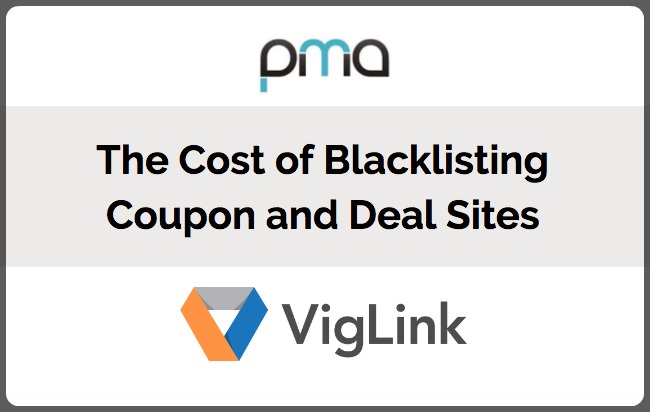
The Cost of Blacklisting Coupon and Deal Sites

Guest post from Industry Champion Member VigLink.
There is no doubt that a movement is afoot in the affiliate space, specifically merchants moving away from deal and coupon sites. On the surface, it would appear a good move. We all know deal and coupon sites in general have a checkered past, including:
- TM bidding
- Misleading and/or stale offers
- No original content
- Scraping coupons, deals, and promotions
- The proliferation of deals further deteriorating retail margins
The net impact of this was a large-scale movement by merchants away from deal sites, and rightfully so, as bad behavior colored the deal and coupon segment. Today’s merchant sentiment is, “We ONLY want content sites.” In a recent survey VigLink conducted of 500 publishers and 100 merchants, two-thirds of merchants stated their main concern about affiliate marketing is the inability to control quality of content where products are mentioned.
We’re going to take a look into four key areas that merchants need to keep in mind when it comes to deal and coupon traffic.
- If merchants blacklist all deal and coupon sites, their revenue will decline.
- Deal and coupon sites are cleaning up their behavior.
- Metrics show that deal and coupon sites offer key benefits to merchants that are difficult (if not impossible) to replicate with any other type of site.
- There are concrete opportunities and steps that can be taken to achieve success when it comes to deal and coupon sites.
1) Setting expectations – What to expect when you blacklist Deal and Coupon sites as a segment?
- Say goodbye to the low funnel.
- There is no doubt that the absolute bottom of the funnel purchase intent comes out of deal and coupon sites, which is why taking them out of your marketing strategy will likely lead to a net loss in sales. This trend is reinforced by Commission Junction, who reports that over 50% of shoppers made an unplanned purchase after finding a coupon.
- Deal and coupon is the bottom of the funnel choice.
- PartnerCentric research shows online coupons have the highest redemption rate of anydirect marketing channel.
- Order value will decrease and it will not be magically picked up by content sites.
- VigLink’s data shows that merchants that block deal and coupon sites do not recover the lost revenue through alternate channels. The sites simply lose exposure.
- Your competitors will secure an advantage.
- When a deal and coupon site loses affiliation with a brand, they don’t continue sending that merchant free sales. They simply put their marketing efforts toward the competitors.
- You may have lost an edge on getting someone to consider switching brands.
- Forrester research states that 47% of consumers are likely to try a new brand when receiving a coupon on their smartphone while shopping in-store.
2) Deal and coupon sites as good citizens – Are deal and coupon sites really cleaning up their behavior?
- Deal and coupon site owners are listening and are willing to engage in constructive dialog.
- Major deal and coupon sites have employed client service and business development teams who focus on recruiting brands to advertise and participate on their platforms. This is a substantial step toward embracing the merchant community, and with this embrace comes the requirement to play by the rules. We’re also seeing site owners being much more diligent about updating coupons in a timely manner.
- New tools will give merchants greater brand control by giving them the ability create/post coupons directly.
- Many premium deal sites such as RetailMeNot led the way by introducing ways for retailers to actively control their coupon offering and their on-site brand representation. Sites like Dans Deals have highly curated blog-style coupons and deals, while Savings.com has an Expert Advice section with tips on everything, from recipes to fitness. This trend is catching on throughout the coupon community. Retailers are also using deals and coupons in more surgical ways, such as closeouts and new product launches.
- Deal and coupon sites are abandoning TM bidding.
-
- As VigLink’s Director of Publisher Services Leah Salloway describes this trend, “Deal and coupon sites are definitely more cognizant these days about following the T’s and C’s of a merchant program to not fall afoul of their rules and ultimately lose that revenue, including TM bidding.”
3) Benefits of working with deal and coupon sites – What are some compelling metrics for a merchant to consider?
- Deal and coupon sites are a rich source of new customer acquisition.
- VigLink’s data shows that the deal and coupon channel delivers 1 in 10 new to file customers across all transactions. Further, Commission Junction research shows 52% of their survey respondents said that online coupons influence their choice to shop at a new retailer.
- Deal and coupon sites are used by the consumer demo everyone wants.
- 54% of affluent shoppers (defined as the 58.5 million adults living in US households with at least $100,000 in annual household income) use online coupons once a month or more and 23% do so at least once a week. (Ipsos research)
- The metrics on online bargain shoppers and coupon usage continue to show dramatic growth.
- The majority of U.S. internet users (that’s 92.5 million consumers) say they plan to use online coupons this year. And 74% of these online coupon shoppers say they search multiple coupon sources every week. (PartnerCentric research).
- Coupons that are socially posted are going viral.
- 56.1% of mothers share coupons on social media. Of these, more than one-quarter post about coupons at least somewhat frequently (eMarketer).
- The number of international consumers is growing.
- Along with new customer acquisition, reaching the international customer is critical in the new global economy. The growing demographic of Chinese shoppers is a key example. In an article in Branding Magazine, a survey showed more than half of all Chinese online shopping respondents expected brands to offer them deals on social media, reinforcing the influence of deal sites.
- Coupon and deal sites offer a cross platform and in-store advantage.
-
- Coupons are not only useful in the classic desktop surfing model. Mobile coupons and printable coupons for use online or in a brick-and-mortar environment are now a staple of the deal and coupon sites’ value proposition. Nearly 70% of mobile coupon users will access coupons via smartphone this year (Full Tilt Marketing). Additionally, 68% of customers strongly believe that digital coupons have a positive impact on a retailer’s brand, and 68% of consumers also stated that coupons generate loyalty. (Forrester State of Digital Coupons Report).
4) Best practices- What are the next steps for success?
- Start conversations and maintain communication.
- Deal and coupon sites often run by full teams. Engage them. Ensure that they have reviewed and fully understand your terms of service.
- Blacklist deal and coupon sites at an individual level, not a category level.
- Banning an entire category of affiliates is like barring all customers who wear a hat from entering your store; it doesn’t make any sense. The tools are available to blacklist/whitelist on an individual basis, and they should be used to the merchant’s benefit.
- Monitor the metrics by affiliate and curate based on results.
- Not all deal and coupon sites are created equal and shouldn’t be treated as such. It’s worth the time to review key metrics such as sell through, customer LTV, product sales mix, AOV and other metrics critical to your business to determine which sites to keep in your program.
- If you are having trouble with a deal and coupon site, consider going to someone with leverage (i.e. VigLink).
-
- A platform like VigLink that has deal and coupon sites in their network pays these sites earnings from many merchants. This provides the merchant leverage for deal and coupon sites to play by the rules.
References:
The State Of Digital Coupons, How Digital Coupons Are Adapting To Mobile And Omnichannel. A Forrester Consulting Thought Leadership Paper Commissioned By RetailMeNot. August 2014. Benefits to Working with Coupon Affiliates. Schaaf Partner Centric. Date Unknown.
WHY YOU SHOULDN’T IGNORE COUPON SITES. A white paper exploring how coupon sites impact the consumer purchase journey. CJ Insights 2013. CJ Affiliate by Conversant.
https://www.fulltiltmarketing.net/2014/02/21/going-viral-with-the-rapid-growth-digital-coupons/ https://www.emarketer.com/Article/Mothers-Share-Their-Brand-Coupon-Preferences/1010220 Ipsos Consumer Barometer, Jan. 2012
VigLink Internal Research. 2017.

 Follow
Follow
Greg Hoffman
September 12, 2017 at 10:22 amI proudly blacklist all coupon, loyalty and paid search from sub-affiliate networks because you offer no transparency or control. I work with a handful of those sites directly through the main network. I don’t want them sneaking in the back door you are holding open. I don’t ignore these sites. I just refuse to work with them through your network.
Every Monday morning for the last four years, I’ve sent messages to your “quality control” asking for sites to stop promoting my merchants. It’s a revolving door. Every. Monday.
Wade Tonkin
September 14, 2017 at 12:40 pmI have a similar experience. If the sub-networks did a better job of offering transparency to merchants, there would be more trust of sub networks. You can see it discussed on affiliate boards and Facebook groups “if they don’t approve me, I just promote through (insert sub net here) …
We get that there are some sites that prefer working through the tools sub networks provide and if the sub networks honestly tried to meet us in the middle so that our program policies and brand concerns were honored the same as if the affiliate worked with us directly, we’d be all about doing more with them.
Craig McGlynn
September 19, 2017 at 11:40 amWade, getting feedback from thought leaders like you was my intention for this article, so thank you for your comments. The gist of your comment appears to be that a lack of transparency puts you at risk as an advertiser from a platform like VigLink. Coming from an advertiser background myself, I totally agree and appreciate that point of view. That is why large platforms like VigLink actively offer transparency reports listing which publishers are driving you traffic. If you don’t currently have access to this, please get in touch with our team at merchants@viglink.com and we will set you up. Many thanks again for your insight.
Cody Pape
September 19, 2017 at 11:36 amThan you for your feedback, Greg. Our merchant dashboard provides transparency as to where traffic is being driven from. We also offer various forms of quality control – promotional method based sensitivity filters, regional filters, and one off blacklist removals for specific partners merchants don’t want to work with. Additionally, our support team conducts regular reviews of all new publisher sign-up’s prior to approving them for affiliation through VigLink. Our network quality team reviews new, revenue-generating publishers for potential noncompliance as well. If you have any further concerns, we’re happy to discuss at nq@viglink.com.